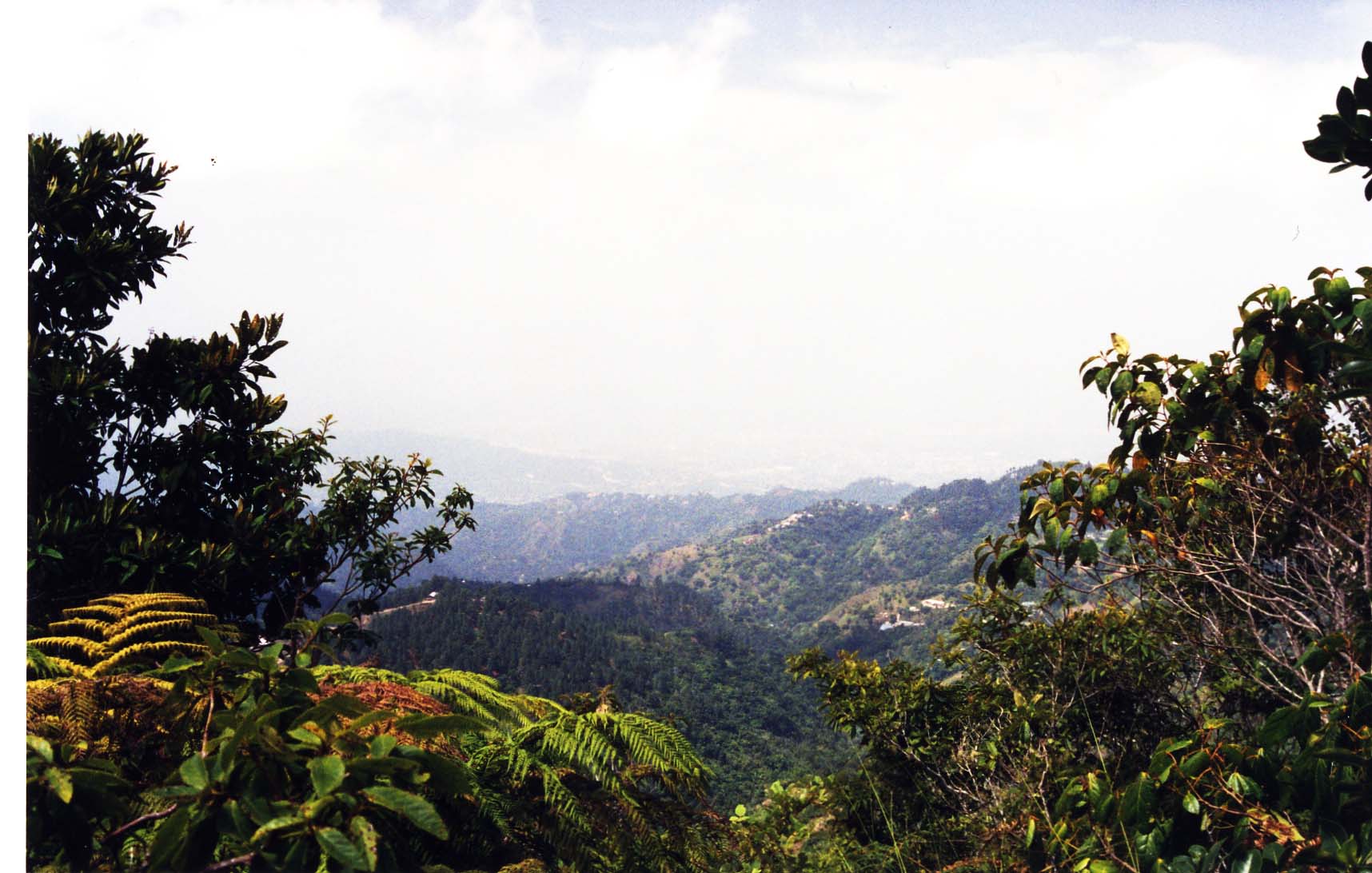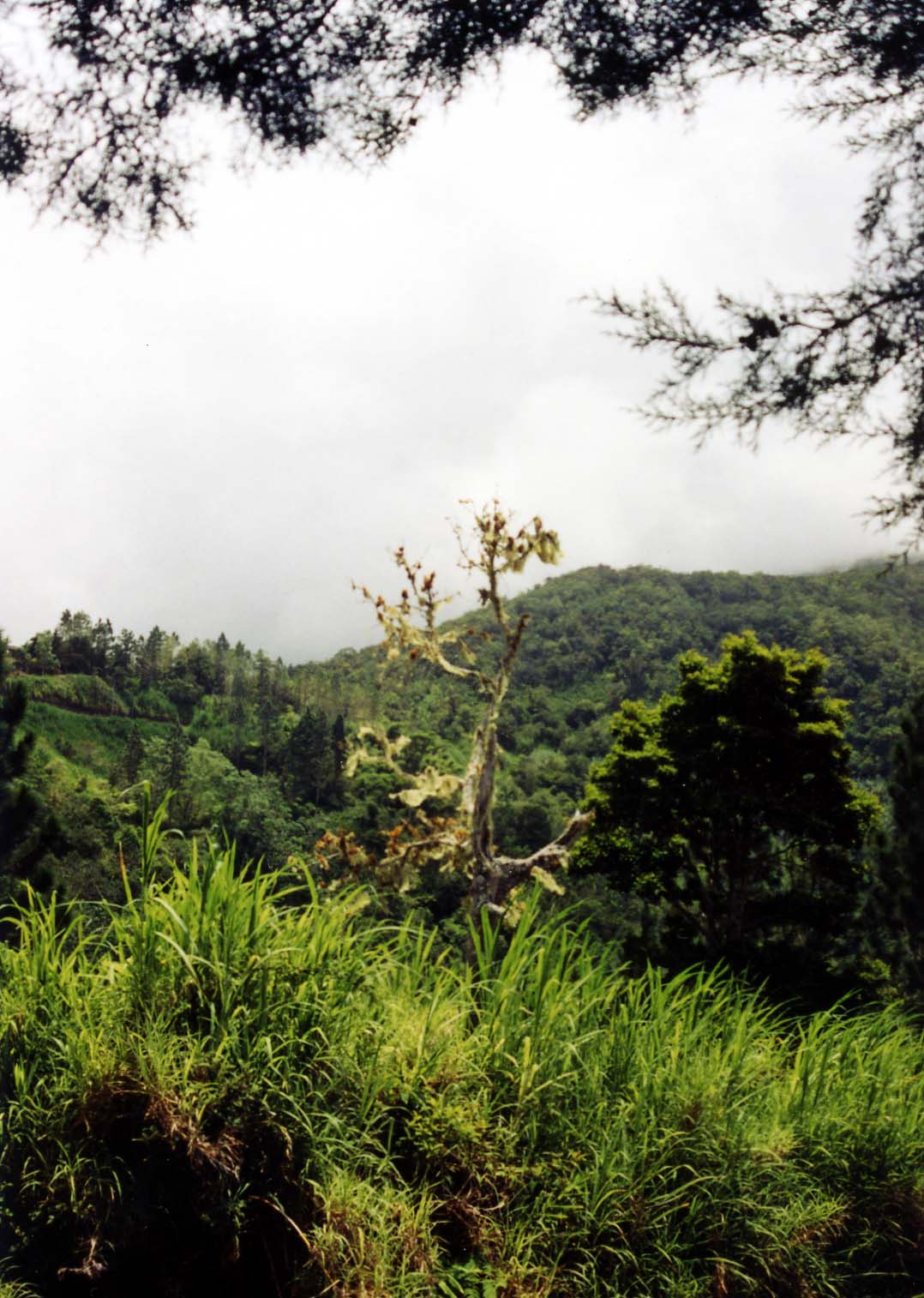

“It is the fairest island eyes have beheld; mountainous
and the land seems to touch the sky."
Christopher
Columbus, 1494
Shrouded almost perpetually by mists that give Jamaica’s highest mountains their bluish color, the Blue Mountain range sprawls across the eastern portion of the island for a length of 28 miles and an average width of about 12 miles. They rise steeply in an area so compact that it is possible to drive from the coastal plains to an elevation of over 7,000 feet in less than an hour.
 |
Tree Ferns |
When Columbus discovered Jamaica in 1494, the mountains were heavily forested. Early Spanish settlers established their hatos or cattle ranches at the foot of the Blue Mountains on the southern coast at Liguanea, the Yallahs Valley and around the Morant Bay area. However, their numbers were few and it was after the island was captured by the English that the lower slopes were cleared for farming and the forests were harvested to meet the great demand in England for Jamaican hardwoods. Today, economic and population pressures have pushed the forest line to around 2000 ft. on the northern slopes and almost 5000 ft. on the southern slopes.
The 194,000 acre Blue Mountain and John Crow Mountain National Park was established in 1992 to preserve some of the remaining forests and to protect the island’s largest watershed. The park comprises about 6% of Jamaica’s total land mass. These diverse mountain forests have more than 800 species of endemic plants, the world’s second largest butterfly, Papilo homerus, 200 species of resident and migrant birds and is one of the largest migratory bird habitats in the Caribbean. There are also more than 500 species of flowering plants of which almost one half are native to Jamaica. Of these, the most interesting is perhaps the Jamaican bamboo, Chusquea abietifolia, that flowers only once every 33 years. The next flowering will take place in 2017.
From Kingston, two approaches via Irish Town and Guava Ridge converge at the town of Section where the road continues down to Bull Bay on the North Coast. This is the only road that traverses the Blue Mountains and is the main access to the region. All other roads follow the river valleys from the main road around the island to penetrate the lower slopes of the Blue Mountains including the Port Antonio - Bowden road that follows the Rio Grande between the Blue Mountains and the John Crow Mountains.
It is this eastern face of the Blue Mountains that receives more than 300 inches of rain each year, providing water for almost one half of Jamaica’s population. Together with the John Crow Mountains, this area is Jamaica’s last remaining rainforest where many rare and exotic plants can be found as well as the world’s second largest butterfly. The land is particularly rugged and when the Spanish fled Jamaica, their freed slaves escaped to these mountains. The Winward Maroons, as they later became known, were led by Nanny, a legendary chieftainess who is said to have possessed magical powers. They harassed the English for decades before signing a treaty whereby they were allowed to live in relative autonomy.
There are some very pleasant walks from the small towns along the Port Antonio - Bowden road, especially at Ginger House where there is a pretty waterfall beside a cave and a mineral spring. A swinging bridge across the river connects Ginger House to Cornwall Barracks where British troops once launched their assaults on the Winward Maroons. However, hikes up into the forests are usually very rugged, river crossing, machete wielding, trailblazing affairs. For intrepid explorers, there are trails from the Rio Grande valley to Nanny Town, the original hideout of the Winward Maroons, and to Bath Fountain in St. Thomas where there are hot mineral springs.
The Peak, 7402 ft.
 |
Hardwar Gap |
Other Trails
The true atmosphere of the Blue Mountains is found in the hundreds of paths that connect
villages with planting grounds and other villages. These are not recreational trails but
utilitarian tracks used by people who live and work in the mountains. There are some nice walks around Newcastle on the Kingston to Buff Bay Road
where trails lead to Catherine’s Peak and Mt. Horeb. Beyond Newcastle, the Holywell forest
reserve at Hardwar Gap is noted for its tree ferns and birdlife.
On the Guava Ridge to Section road, there is a short walk (one mile) from Content Gap to Charlottenberg, an old great house with fine antiques and a beautiful garden. Closer to Section is the road to Clydesdale, an old coffee plantation that is now used as a nursery for the Forestry Department. About two and a half miles above Clydesdale, is the Cinchona Botanical Garden that was established in 1868 to grow cinchona trees for the manufacture of quinine. When the project failed, it was taken over by the Jamaica Department of Gardens and Plantations. Although it is now much reduced in size and in semi-abandoned condition, there is a wonderful collection of trees and flowering shrubs from all over the world.
Blue Mountain Coffee
The once forested, lower slopes of the Blue Mountains are now mostly grasslands but some areas
are used for the cultivation of vegetables, spices and the world renowned Blue Mountain coffee.
The first coffee seedlings were brought to Jamaica from Hispaniola in 1728 by the Governor, Sir
Nicholas Lawes. The mountain slopes were cleared to establish coffee plantations and by the
first quarter of the 19th century, Jamaica was the leading coffee producer in the world. The
industry fell into decline after Emancipation when Jamaica could no longer compete with slave
owning countries like Brazil and Cuba.
Today, Jamaican Blue Mountain coffee is considered to be among the best of the gourmet coffees in the world. To ensure the quality, the Jamaica Coffee Industry Board set standards for the coffee beans and the processing in order to carry the ‘Blue Mountain Coffee’ label. 90% of the island’s production is exported to Japan.
Although some coffee estates remain, most of the beans are grown on small plots by local farmers. Considering the retail price of Jamaican coffee worldwide, the farmers get a pittance for their crop and some opt to roast and sell their own beans. A number of them can be found on the Kingston-Buff Bay road near the little town of Section. The process of hand picking ripe berries then drying, curing and roasting the beans is time consuming. Each farmer has his own ‘secret’ process and is happy to explain why his is the very best. It’s an excellent opportunity for coffee connoisseurs to sample a variety of roasts and to purchase a truly unique product.
Best Times to Go:
It is safer
to hike in the Blue Mountains during the dry period from December to April
because its numerous, rapidly flowing rivers create floods and landslides
during heavy rains. It is also the time when the rest of the island is
most comfortable.
Getting There:
The Blue Mountains can be approached from various
points along the coastal main road, but the most popular route is from the capital city of
Kingston. Buses travel between the major towns and mini-buses connect towns to villages. From
Kingston, most buses to the Blue Mountains depart from Papine.
Clothing/Gear:
Comfortable
clothing and walking shoes, a warm jacket and pants, rain gear, a hat with
brim, suntan lotion, insect repellent, flashlight, and a water bottle.
General Information: To arrange a Blue Mountain trek, hikers should plan to spend the night close to the
trailhead. Hikes get underway between 1:00 a.m. and 5:00 a.m. so as to reach the top before the
mist obscures the view. Three places to overnight are Whitfield Hall (Tel-Kingston: 876-927-0986), Wildflower Lodge (Tel-Kingston: 876-929-5394) and
Pine Grove (Tel-Kingston: 876-977-8009, Fax: 876-977-8001). Whitfield Hall offers budget bunk-style
accommodations with shared bathrooms, no hot water, and a kitchen that is available for
preparing your own meals. Rooms at Wildflower Lodge are small with sink, toilet and communal showers. There is no electricity or hot water. Meals are available on request. Pine Grove has individual bedrooms with en suite bathrooms, hot water
and will prepare meals on request. All three will arrange to pick up guests at Mavis Bank near the
end of the bus route or at Papine. 2 WD vehicles may be left safely at the Mavis Bank Police Station.
Bird watchers and botanists favor the forested areas of the Hardwar Gap and the Rio Grande
Valley. There are campsites and inexpensive but very rustic cabins at Holywell forest reserve. Visitors must bring
their own food and bedding and arrangements must be made in advance at the Forestry Department
in Kingston (173 Constant Spring Road, Tel: 876-924-2667).
Most people prefer to use Port Antonio as a base for visiting the Rio Grande Valley.
Around Newcastle, the Jamaica Defence Force rents some very basic military cottages.
(Tel: 876-944-8230). Strawberry Hill is a nearby mountain-top resort that offers guided
hikes. Rooms cost US$300-600 per night (Tel: 876-944-8400, Fax: 876-944-8408).
With prior arrangement, it is possible to spend the night at Charlottenburg Great House. It
can be reached by a short walk from Content Gap or a longer walk from Gordon Town. (Tel:876-978-3530 or
876-927-0752). Clydesdale offers basic rooms and campsites are available at Cinchona Botanical
Gardens. Arrangements for both must be made in Kingston at the Forestry Department. (173
Constant Spring Road, Tel: 876-924-2667). Starlight Chalet will arrange nature walks and mountain hiking trips for their guests.
A day trip to the Blue Mountains is easily
arranged through the travel desk of any hotel. However, some planning is required for those
wanting to spend more than a day as arrangements must be made in advance.
Planning Tips:
Important Resources:
The Natural History Society of Jamaica Occasionally, the Natural History Society of Jamaica plans
field trips into the Blue Mountains and nearby John Crow Mountains with
special emphasis on their flora and fauna. Contact them directly for information on dates and prices. The Jamaica Forestry Department The Forestry Department provides campsites and/or basic cabins at Portland Gap (along the
Blue Mountain Peak trail), Holywell Forest Reserve, Clydesdale and Cinchona Botanical Gardens. Reservations must be made in advance at their
office in Kingston.
Blue Mountain Tours
Blue Mountain Tours has bicycle trips from Hardwar Gap down to Buff Bay. There are frequent
stops for photographs as the ride passes through tropical rainforests and coffee plantations
with dramatic mountain views. The tour package includes hotel pick-up and drop-off as well as
lunch and snacks. Arrangements may be made at your hotel tour desk. Related Books:
Adventures Great and Small © copyright 1996-2005
The Department of Life Sciences,
University of the West Indies
Mona, Kingston 7, Jamaica WI
Tel: 876-977-6938
Fax: 876-977-1075
Email: naturalhistory@hotmail.com
173 Constant Spring Road, Kingston 8, Jamaica W.I.
Tel: 876-924-2667 or 876-924-2668
Fax: 876-924-2626
Email: forestrydepartment@forestry.gov.jm
Tel: 876-974-7075
Fax: 876-974-0635
Email: info@bmtoursja.com
Tel: 876-977-6938.
